The MSI Z170A Gaming M7 Review: The Step Up to Skylake
by Ian Cutress on September 21, 2015 12:30 PM EST- Posted in
- Motherboards
- Gaming
- MSI
- Skylake
- Z170
CPU Performance, Short Form
For our motherboard reviews, we use our shortform testing method. These tests usually focus on if a motherboard is using MultiCore Turbo (the feature used to have maximum turbo on at all times, giving a frequency advantage), or if there are slight gains to be had from tweaking the firmware. We leave the BIOS settings at default and memory at JEDEC (DDR4-2133 C15) for these tests, making it very easy to see which motherboards have MCT enabled by default.
Video Conversion – Handbrake v0.9.9: link
Handbrake is a media conversion tool that was initially designed to help DVD ISOs and Video CDs into more common video formats. The principle today is still the same, primarily as an output for H.264 + AAC/MP3 audio within an MKV container. We test two files, one with small frame sizes (640x266 24 FPS film running for 2h20) and one with super large frame sizes (double-UHD, 3840x4320 at 30 FPS animation short) to show where certain processor designs give better boosts for large frames which might not be obvious in small frame environments.
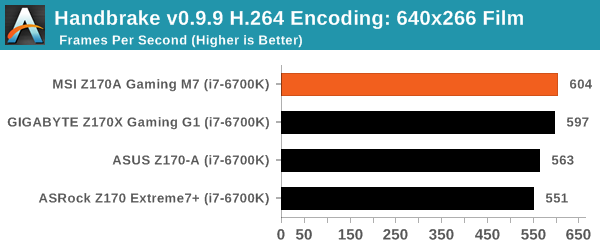
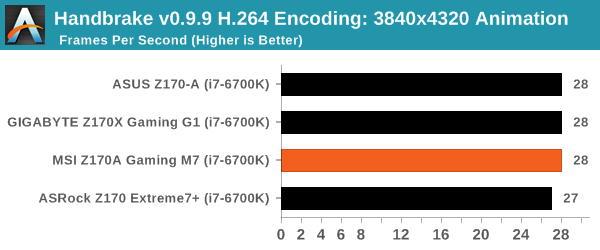
Compression – WinRAR 5.0.1: link
Our WinRAR test from 2013 is updated to the latest version of WinRAR at the start of 2014. We compress a set of 2867 files across 320 folders totaling 1.52 GB in size – 95% of these files are small typical website files, and the rest (90% of the size) are small 30 second 720p videos.

Point Calculations – 3D Movement Algorithm Test: link
3DPM is a self-penned benchmark, taking basic 3D movement algorithms used in Brownian Motion simulations and testing them for speed. High floating point performance, MHz and IPC wins in the single thread version, whereas the multithread version has to handle the threads and loves more cores. For a brief explanation of the platform agnostic coding behind this benchmark, see my forum post here.
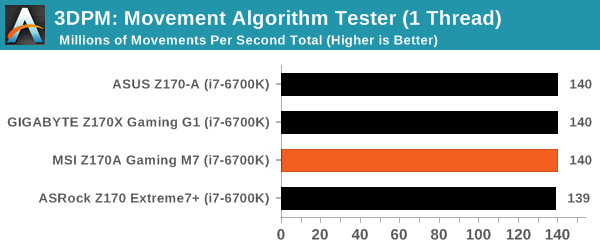
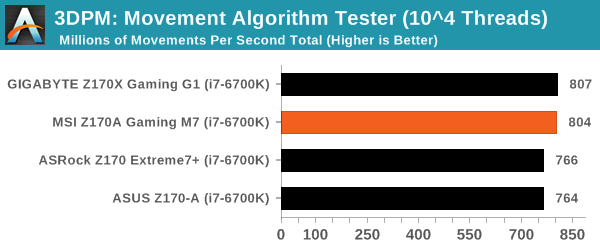
Image Manipulation – FastStone Image Viewer 4.9: link
FastStone is the program I use to perform quick or bulk actions on images, such as resizing, adjusting for color and cropping. In our test we take a series of 170 images in various sizes and formats and convert them all into 640x480 .gif files, maintaining the aspect ratio. FastStone does not use multithreading for this test, and thus single threaded performance is often the winner.
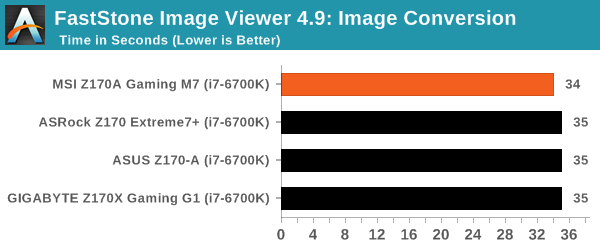
Rendering – POV-Ray 3.7: link
The Persistence of Vision RayTracer, or POV-Ray, is a freeware package for as the name suggests, ray tracing. It is a pure renderer, rather than modeling software, but the latest beta version contains a handy benchmark for stressing all processing threads on a platform. We have been using this test in motherboard reviews to test memory stability at various CPU speeds to good effect – if it passes the test, the IMC in the CPU is stable for a given CPU speed. As a CPU test, it runs for approximately 2-3 minutes on high end platforms.
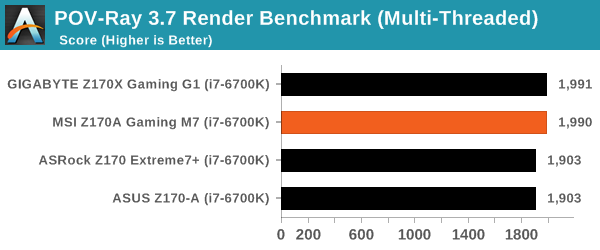
Synthetic – 7-Zip 9.2: link
As an open source compression tool, 7-Zip is a popular tool for making sets of files easier to handle and transfer. The software offers up its own benchmark, to which we report the result.
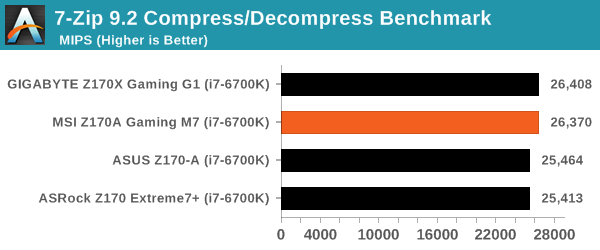










56 Comments
View All Comments
Morawka - Monday, September 21, 2015 - link
The chipset has been upgraded to pci express 3.0 with 20 lanes. the cpu still has it's own dedicated 16x link separate from the 20 lanes to the chipset. the cpu's latency is greatly reduced vs chipset, so that's why graphics cards use it.all the new M.2 drives use the chipset bandwidth now at x4 PCI E 3.0, leaving 16X for more M.2's, Sata, USB, Etc..
DanNeely - Monday, September 21, 2015 - link
You have 16 3.0 lanes on the CPU and up to 20 3.0 lanes on the south bridge. Up to is a very important qualifier; most boards will have significantly fewer available. What the SB has is 26 high speed IO ports that can be used for a sata 3 port, a USB3 port, a PCIe 3.0 lane, or be bundled together for an sata express or m.2 SSD controller. Take all 6 sata ports, all 10 USB3 ports from the chipset and you've only got 10 lanes left for SSD connections or PCIe slots. The maximum configuration for SB lanes is PCIe x4; because the SB itself only has a 4 lane equivalent uplink to the CPU.K_Space - Tuesday, September 22, 2015 - link
Thanks @Morawka and @DanNeely,Am I right in thinking that in this case, if Cross Fire is consuming the 16x lanes from the CPU, then the SSD can get it's x4 PCI-E 3.0 lanes from the PCH (assuming sufficent free lanes which this should have)?
DanNeely - Tuesday, September 22, 2015 - link
yes.K_Space - Tuesday, September 22, 2015 - link
Much obliged.Gigaplex - Tuesday, September 22, 2015 - link
Latency isn't the issue, it's bandwidth. In theory you can use the extra lanes as you describe, but only if the motherboard wires up the lanes correctly. Check the motherboard manual for supported configurations.paulhaswood - Monday, September 21, 2015 - link
Awesome review! Im excited to see more lga1151 motherboard reviews and please please please do a lag 1151 mini itx motherboard review!krbrownin - Tuesday, September 22, 2015 - link
Great timing! I just ordered this board two days ago (and lucked out getting a i7 6700k). I can't wait now to start my build and try it out.I wonder why MSI removed Sound Blaster Cinema and went with this Nahimic audio software? Also I found the Killer Network worked fine if you removed the Qualcomm Suite (that automatically installs with Killer), and installed the plain Killer NIC drivers. I've been using it over a year now that way with not a single prob. Always had good luck with MSI products, so here's hoping that streak continues. It's a good looking board too.
JinzoBlazer - Tuesday, September 22, 2015 - link
Ian, slightly off topic. According to MSI's website the H170-M3 supports unbuffered ECC memory. Is this an error on MSI's part? Any indication if:* This board supports ECC / certain Z170A boards could support ECC with a Xeon (or whatever other CPUs in ARK are listed as having ECC support)?
* H170-M3 just has some extra traces that the Z170-M7 does not? Is there any dependence on chipset for ECC support with an on die "northbridge"?
http://www.msi.com/product/mb/H170-GAMING-M3.html#...
PitneFor - Tuesday, September 22, 2015 - link
people still buy this expensive crap? overclocking? what a huge was of time and money. this article is for the 1% . no one cares anymore about high end "gaming" crap. No one cares about 4k. It's all hype for the industry. you want to stare at tiny icons, text you cant read, and horrible fps so badly ?! and you want to PAY other people money to do this. blows my mind